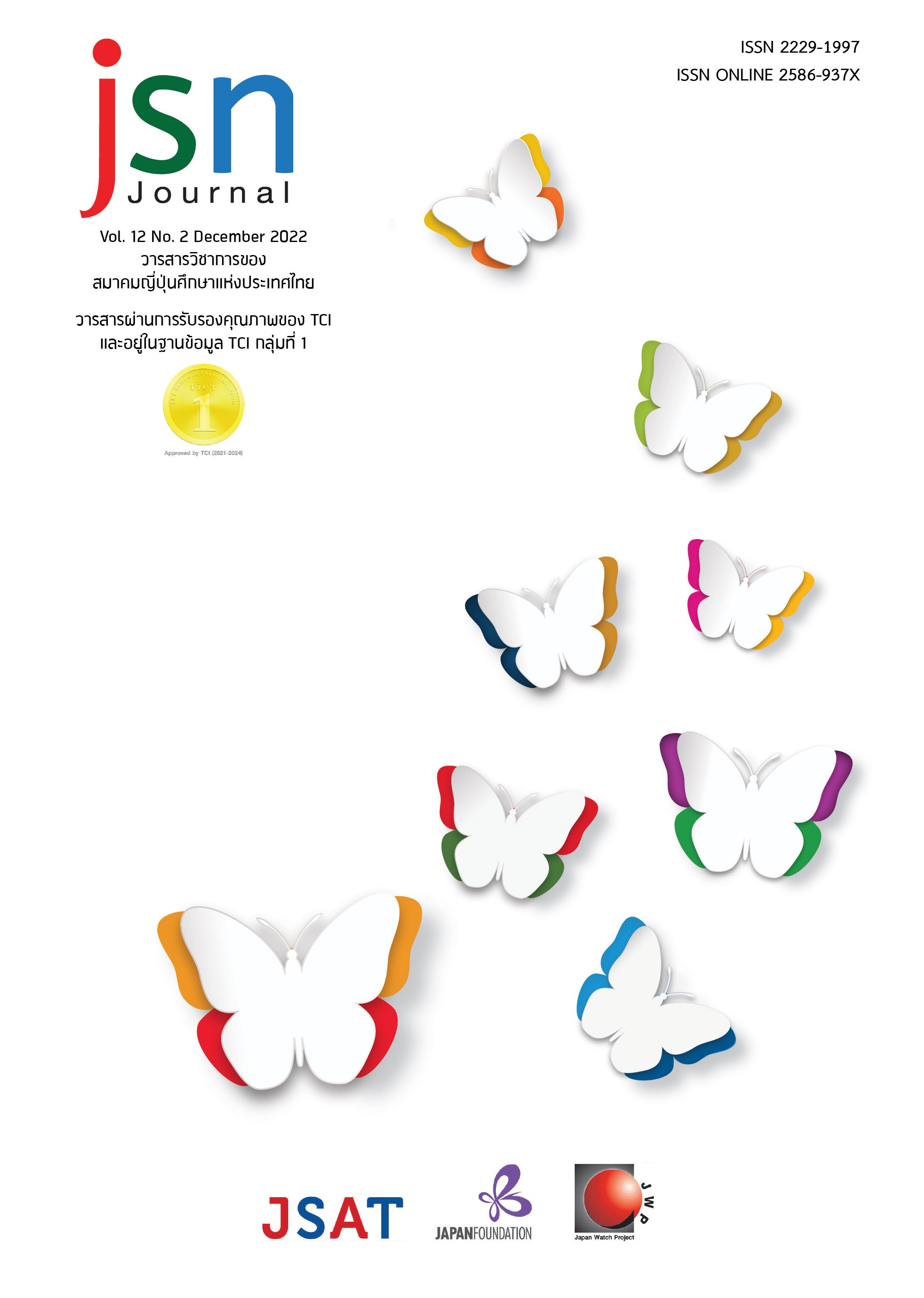A Study of Errors and Guidelines for Elementary Japanese Essays: The University Students of a Japanese Business Course at the Panyapiwat Institute of Management, Thailand
Main Article Content
Abstract
The purpose of this research was to study the types of errors, solutions, and preventions of errors in a beginner’s class of Japanese essay writing. The participants in this study were 50 regular second-year undergraduates enrolled in the BJ61248 Japanese Writing course at the Panyapiwat Institute of Management. The method was to assign the students to write a Japanese essay on two topics per person: “My family” and “My town,” and the total number of sentences was to be 883. The results showed that there were 339 errors in the Japanese essays. Word-level errors had a higher rate at 193 errors, followed by sentence-level errors at 133, and discourse-level errors at 13. The types of word-level errors were mistakes in spelling, writing Kanji, and using inappropriate words. In the case of the sentence-level errors, it was using wrong particles and predicates, including inappropriate connections of sentences. In the case of discourse-level errors, wrong attributes and classifiers of persons or things were used. In order to prevent errors in essay writing, not only should particles be used correctly, but teaching vocabulary with emphasis on spelling and writing Kanji, and learning types of words and the meaning of words, should be employed. In addition, lecturers should educate Japanese essay writers by moving from simple to complex sentences. This will help learners to be able to transcribe stories and the chronology of written content accurately according to the structure and context better.
Article Details

This work is licensed under a Creative Commons Attribution-NonCommercial-NoDerivatives 4.0 International License.
ข้อความและข้อคิดเห็นต่างๆ ในบทความเป็นของผู้เขียนบทความนั้นๆ ไม่ใช่ความเห็นของกองบรรณาธิการหรือของวารสาร jsn Journal
References
ราชบัณฑิตยสถาน.(2554). พจนานุกรม ฉบับราชบัณฑิตยสถาน พ.ศ.2554. [ออนไลน์]. https://dictionary.orst.go.th/
วรรณี โสมประยูร. (2535). การสอนภาษาไทยระดับประถมศึกษา. ไทยวัฒนาพานิช.
ศิริมา ปุรินทราภิบาล. (2010). ภาษาแม่กับการเรียนภาษาต่างประเทศ. Journal of Humanities and Social Sciences, 6(2), 47-78.
สุณีย์รัตน์ เนียรเจริญสุข. (2551). วิเคราะห์ข้อผิดพลาดด้านการเขียนของนักศึกษาไทยที่เรียนภาษาญี่ปุ่นระดับสูง. วารสารศิลปศาสตร์ 8(1), 109-131.
สนิท ตั้งทวี. (2538). การใช้ภาษาเชิงปฎิบัติ. (พิมพ์ครั้งที่ 2). โอเดียนสโตร์.
เสนีย์ วิลาวรรณ. (2547). ชุดพัฒนาทักษะภาษา ชั้นมัธยมศึกษาปีที่ 5 เล่ม 4. สำนักพิมพ์วัฒนาพานิช.
สมเกียรติ เชวงกิจวณิช และ ชิซุกุ ยานางิซาวะ. (2560). เทคนิคพื้นฐานการเขียนเรียงความภาษาญี่ปุ่น. (พิมพ์ครั้งที่ 1). สมาคมส่งเสริมเทคโนโลยี (ไทย-ญี่ปุ่น).
สมพร มันตะสูตร. (2540). การเขียนเพื่อการสื่อสาร. (พิมพ์ครั้งที่ 2). โอเดียนสโตร์.
สร้อยสุดา ณ ระนอง. (2546). การศึกษาประโยคผิดในเรียงความภาษาญี่ปุ่นขั้นต้นและขั้นกลางของนักศึกษาชาวไทย: ปัญหาการใช้คำช่วย. การประชุมทางวิชาการของมหาวิทยาลัยเกษตรศาสตร์ครั้งที่ 41, 448-455.
小野田亮介 (2012). 初等教育において習慣化可能な作文課題および実施方法の検討—リレー作文を使用して—. 『教育心理学研究』60(4), 402-415.
作文クラブ.「 作文を書く6つの手順」Retrieved from https://service.zkai.co.jp/el/course/sakubun_club/sakubun-kakikata/6steps.html
ちょこまな.「上達する作文の書き方8つ|基本からワンランク上を目指す書き方まで徹底解説!」 Retrieved from https://b-engineer.co.jp/chokomana/e-s-student/education/1100658
ビアルケ(當山)千咲・柴山真琴・高橋登・ 池上摩希子(2019). 継承日本語学習児における二言語の作文力の発達過程―ドイツの補習校に通う独日国際児の事例から―. 『日本語教育』(172), 102-117.
細川英雄(1993). 留学生日本語作文における格関係表示の誤用について.『早稲田大学日本語研究教育センター紀要』5,70-89.
福田純也・ 石井雄隆 (2016). 中国語を第一言語とする日本語学習者の作文に対する日本語教師の評価―一般化可能性理論を用いた検討―. 『日本教科教育学会誌』39(2),81-89.
楊 帆(2014). 中級日本語学習者の作文における困難点: 文構造の呼応関係について. 『秋田大学国際交流センター紀要』3,15-28.


